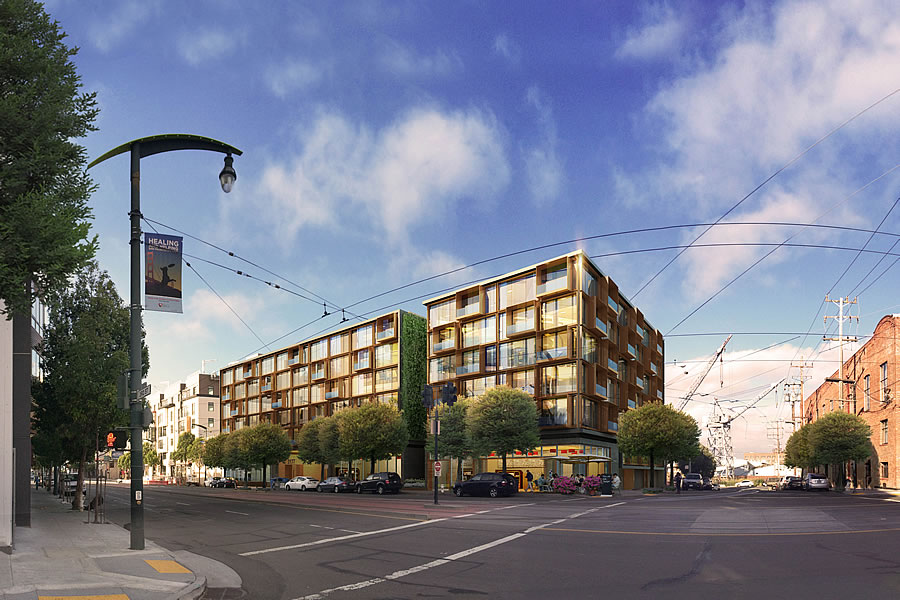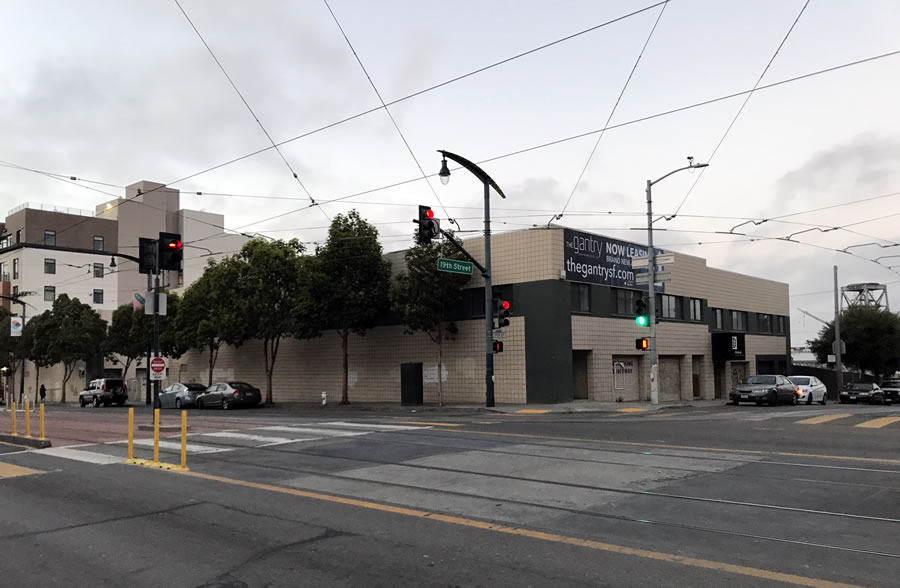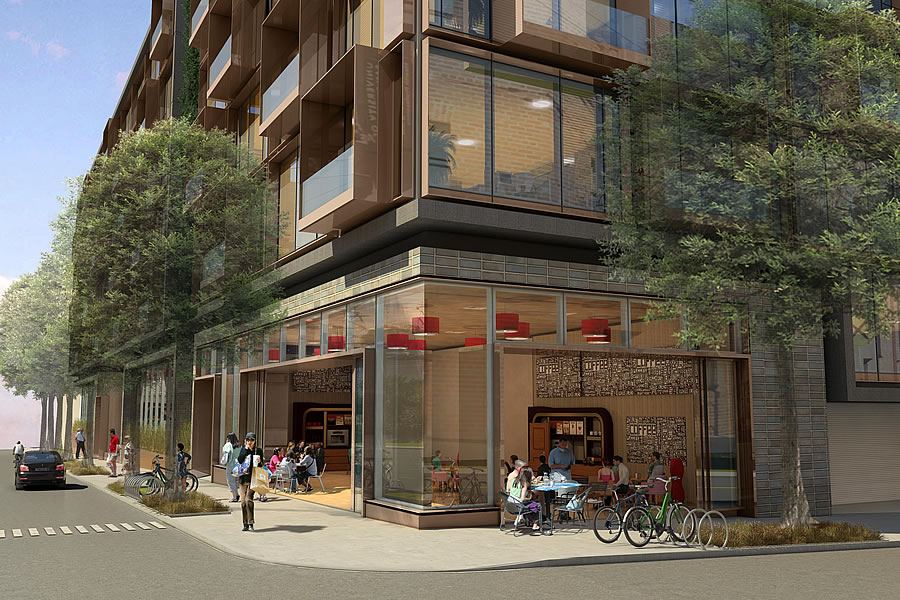Entitled for development early last year, the building permits for the 109-unit project to rise up to seven stories in height at 2177 3rd Street have now been issued and secured, clearing the way for the Dogpatch development on the northeast corner of 3rd and 19th Streets to break ground.
As designed by Woods Bagot and Gary Gee Architects, the development consists of two buildings connected by pedestrian bridges on each floor, with a landscaped courtyard between, a basement garage for 91 cars and 102 bikes with its entrance on 19th, and 3,300 square feet of commercial space fronting Third.
And while approved as originally proposed, with plans to provide 16 percent of the project’s 109 condos at below market rates, the development team is now seeking approval to pay an in-lieu fee to satisfy San Francisco’s Inclusionary Housing Program rather than providing any BMR units on-site, the hearing for which is slated to be held in three weeks time.



Great spot for lots of residential units with the light rail outside the door. Lots of restaurants to choose from, too.
In five years, the Dogpatch will probably take the crown in my mind as Desirable Neighborhood I Never Want to Live In. You’d be dealing with constant traffic from the new arena, UCSF, *and* AT&T if headed downtown, mostly sterile, expensive new construction (hello, Panera), unwalkable as it’s pinned between a freeway and unuseable oceanfront, inconvenient to access for guests, and ongoing construction nearby until no warehouse is left standing. I’d legitimately consider the Tenderloin as an alternative.
Agree on the transportation element, but the waterfront is going to get a lot more usable with all of the parks projects they’re building there.
That traffic isn’t just a problem at AT&T if you’re headed downtown. That neighborhood is flooded with cars for every event there.
being a Dogpatch adjacent resident, I agree with only part of what you say. Unlike Mission Bay, which was a blank canvas, there will always be existing historical context in Dogpatch of converted warehouses, continuing PDR, old SFH on sidestreets. And, things are really looking up for neighborhood serving restaurants (and hopefully more retail too; that would help). And, as aerel points out the waterfront is going to get better and better as parks are developed in southern Mission Bay and through Pier 70. I do agree that some of the new housing is sterile (and some like the new one 3rd @ 23rd are actively ugly). And that the Chase Arena will do nothing for the neighborhood. But, on balance, this really is becoming a great neighborhood.
I meant to also note that the one issue that the neighborhood will probably always deal with is that 3rd Street is really unpleasant, with relatively narrow sidewalks. What should be the major commercial corridor of the neighborhood doesnt’ work very well. It’s a shame that more of the developments have not pulled back slightly from the street to allow more opportunities for better public realm, sidewalk cafes, etc.
Exactly. Those of us who want a restriction on how much of the lot envelope can be built on in part see it as a way to widen the sidewalks and enliven the street level experience. If the city required that 10% of the lots along 3rd had to remain “open space” the logical move would be to use that 10% to widen the sidewalks into POPOS.
Also two of the key blocks (20 to 22nd and 22nd to 23rd) are crazy long, longer even than SoMa blocks. Is there any possibility future developments will add pedestrian paths to break them up?
Most of the human scale activity will occur on the cross streets: 19th, 20th, 22nd. You’re right, 3rd is just a conduit for traffic and not a pleasant place to hang.
Pier 70 will also become a big nexus.
@curmudgen, I think 3rd street’s sidewalk’s are simply a victim of the street’s history. With the buildings already there prior to the T line going in, and the goal to have four lanes of north/south traffic as well as a north/south LRV system plopped onto 3rd street, it doesn’t leave much room for doing much of anything with the sidewalks outside of tearing them up and repaving them in their current width.
agreed. unfortunately the T line was incredibly destructive to doing anything humane along 3rd (well, that AND keeping two lanes of traffic in either direction). Not only is there no room for wide sidewalks, there are also often traffic lanes right along the sidewalk, with none of the psychological protection of a parked car. Milkshake is correct that the planning decision was therefore to rely on cross streets for human-scale, but it is clearly not the intuitive solution and results in an odd neighborhood layout. Really looking forward to Pier 70 adding some more ped-centric environment.
That’s right, because Tenderloin’s about to get gentrified now for the umpteenth time and is no closer than it was a decade ago.
There does need to be a plan for improving the sidewalks. To some extent, I always think of streets with minimal sidewalks as ones that should get the car traffic.
One mixed blessing is the T-Line. The red/grey tracks are rather ugly. The standard for rail tracks in Europe these days is to plant grass all around them. While it’s not a park, it’s better than narrow street surrounded by pavement.
As Panhandle Amigo says “sterile” construction and “unwalkable” streets. This building is a perfect example of the soulless architecture San Francisco continues to embrace. This at a time when other cities are beginning to embrace the emerging new urbanism/new classicism in city planning and architecture. It’s a sustainable approach to urban neighborhoods that recognizes the importance of being committed to a place, of place. The emphasis is on buildings that respect their surroundings, their community and their future inhabitants – that encourage human flourishing.
Dogpatch, Central SOMA, the Hub – the cutting edge of new urbanism/classicism is moving past these types of development. Starchietects whose creations are about their self expression and ego (we have some in SF) and who disregard the imperative of place need not apply.
Of course this building is not a starchitect creation – it’s a cookie cutter of so much already built and to be built in SF. Ironically, one of the few new urbanism/new classicism projects in SF – the Presidio Heights proposal – is being rejected by the City.
One thing about this Dogpatch building – it will be a place you live in for a while, but not a place most would call home.
Ironically, one of the rare exceptions to this in SF
Dave: “New Urbanism/Classicism”, i.e. fake history, has no place in this or any city at this point in time. The place to look for contemporary precedents that don’t have to pretend to be of another era but still offer great, vibrant urban architecture is: all over Europe (Scandinavia, Holland, Germany, Spain, Portugal, Switzerland, France, Austria, etc.) or Japan, or Australia or any number of other places…
That retail space would be great for a small market that this neighborhood desperately needs.